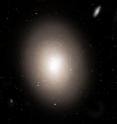The universe does think small
The biggest galaxies in the universe are elliptical galaxies. The largest of these hold over one trillion stars according to astronomical census takers, compared to 400 billion in our Milky Way. However, new research shows that elliptical galaxies actually hold five to ten times as many stars as previously believed. This means that the total number of stars in the universe is likely three times bigger than realized. The hidden stars are known as red dwarfs for their color and small size. Because red dwarfs are small and dim compared to stars like the Sun, astronomers hadn't been able to detect them in galaxies beyond the Milky Way before now. As such, they didn't know how many stars in the universe were red dwarfs.
Scientists used powerful instruments on the Keck Observatory in Hawaii to detect the faint signature of red dwarfs in the cores of eight elliptical galaxies, which are located between about 50 million and 300 million light-years away. They discovered that the red dwarfs, which are only between 10 and 30 percent as massive as the Sun, were much more bountiful than expected.
"As it turns out, the universe thinks small, at least when it comes to star size," said Harvard astronomer Charlie Conroy. "Our stellar inventory has changed dramatically."
"No one knew how many of these stars there were," said Pieter van Dokkum, a Yale University astronomer who led the research. "Different theoretical models predicted a wide range of possibilities, so this answers a long-standing question about just how abundant these stars are."
Their results imply that stellar population counts depend on what type of galaxy astronomers examine, just as a census of the city of New York and the town of Derby, Kansas will find very different population numbers.
"We usually assume other galaxies look like our own. But this suggests other conditions are possible in other galaxies," Conroy stated. "This discovery could have a major impact on our understanding of galaxy formation and evolution."
In particular, galaxies might contain less dark matter - a mysterious substance only detectable due to its gravitational effects - than previous measurements of their masses indicated. Instead, the abundant red dwarfs might contribute more mass than previously calculated.
Source: Harvard-Smithsonian Center for Astrophysics
Articles on the same topic
- Discovery triples number of stars in universeWed, 1 Dec 2010, 18:37:45 UTC
Other sources
- Star count of the universe may triple, new study suggestsfrom Harvard ScienceThu, 2 Dec 2010, 14:01:06 UTC
- Universe's Star Count Could Triplefrom CBSNews - ScienceThu, 2 Dec 2010, 13:31:39 UTC
- Universe's Star Count Could Triplefrom CBSNews - ScienceThu, 2 Dec 2010, 4:00:29 UTC
- Number of stars in universe may be vastly larger than thoughtfrom LA Times - ScienceThu, 2 Dec 2010, 2:00:42 UTC
- Discovery May Triple the Number of Stars In the Universefrom Live ScienceWed, 1 Dec 2010, 23:30:32 UTC
- Star count triples to 300 sextillionfrom CBC: Technology & ScienceWed, 1 Dec 2010, 22:30:40 UTC
- Universe may have more stars than thoughtfrom UPIWed, 1 Dec 2010, 22:00:28 UTC
- Number of Stars May Triple in Astronomers’ New Estimatefrom NY Times ScienceWed, 1 Dec 2010, 20:40:18 UTC
- Universe's Star Count Could Triplefrom CBSNews - ScienceWed, 1 Dec 2010, 20:00:55 UTC
- Newly-Discovered Cache of Red Dwarves Triples the Number of Known Stars in the Universefrom PopSciWed, 1 Dec 2010, 19:34:41 UTC
- The universe does think smallfrom Science BlogWed, 1 Dec 2010, 19:32:27 UTC
- Discovery triples number of stars in universefrom Science DailyWed, 1 Dec 2010, 19:30:47 UTC
- How many stars are there? More than you thoughtfrom Reuters:ScienceWed, 1 Dec 2010, 19:20:14 UTC
- Star bonanza hints at many Earthsfrom BBC News: Science & NatureWed, 1 Dec 2010, 19:00:56 UTC
- Discovery triples number of stars in universefrom PhysorgWed, 1 Dec 2010, 18:30:49 UTC
- Discovery May Triple the Number of Stars In the Universefrom Space.comWed, 1 Dec 2010, 18:30:20 UTC
